Memory Layout for Multiple and Virtual Inheritance
(By Edsko de Vries, January 2006)
Warning. This article is rather technical and assumes a good knowledge of C++ and some assembly language.
In this article we explain the object layout implemented by gcc for multiple and virtual inheritance.
Although in an ideal world C++ programmers should not need to know these details of the compiler internals,
unfortunately the way multiple (and especially virtual) inheritance is implemented has various non-obvious
consequences for writing C++ code (in particular, for downcasting pointers, using pointers to pointers, and
the invocation order of constructors for virtual bases). If you understand how multiple inheritance is
implemented, you will be able anticipate these consequences and deal with them in your code. Also, it is
useful to understand the cost of using virtual inheritance if you care about efficiency. Finally, it is
interesting :-)
Multiple Inheritance
First we consider the relatively simple case of (non-virtual) multiple inheritance. Consider the following
C++ class hierarchy.
class Top {p ublic: int a; }; class Left : public Top {p ublic: int b; }; class Right : public Top {p ublic: int c; }; class Bottom : public Left, public Right {p ublic: int d; };
Using a UML diagram, we can represent this hierarchy as
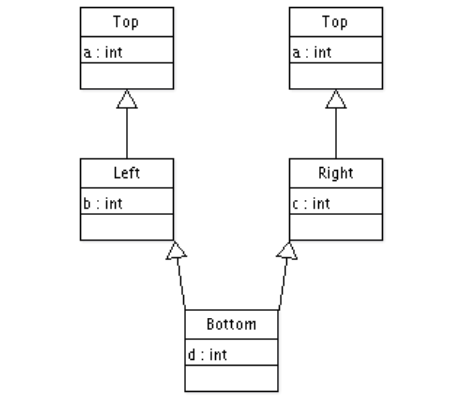
Note that Top is inherited from twice (this is known as repeated inheritance in Eiffel). This means that an
object bottom of type Bottom will have two attributes called a (accessed as bottom.Left::a and
bottom.Right::a).
How are Left, Right and Bottom laid out in memory? We show the simplest case first. Left and Right have the
following structure:
Note that the first attribute is the attribute inherited from Top. This means that after the following two
assignments
Left* left = new Left(); Top* top = left;
left and top can point to the exact same address, and we can treat the Left object as if it were a Top object
(and obviously a similar thing happens for Right). What about Bottom? gcc suggests
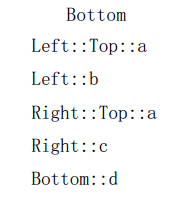
Now what happens when we upcast a Bottom pointer?
Bottom* bottom = new Bottom(); Left* left = bottom;
This works out nicely. Because of the memory layout, we can treat an object of type Bottom as if it were an
object of type Left, because the memory layout of both classes coincide. However, what happens when we upcast
to Right?
Right* right = bottom;
For this to work, we have to adjust the pointer value to make it point to the corresponding section of the
Bottom layout:


After this adjustment, we can access bottom through the right pointer as a normal Right object; however,
bottom and right now point to different memory locations. For completeness' sake, consider what would happen
when we do
Top* top = bottom;
Right, nothing at all. This statement is ambiguous: the compiler will complain
error: `Top' is an ambiguous base of `Bottom'
The two possibilities can be disambiguated using
Top* topL = (Left*) bottom;
Top* topR = (Right*) bottom;
After these two assignments, topL and left will point to the same address, as will topR and right.
Virtual Inheritance
To avoid the repeated inheritance of Top, we must inherit virtually from Top:
class Top {p ublic: int a; }; class Left : virtual public Top {p ublic: int b; }; class Right : virtual public Top {p ublic: int c; }; class Bottom : public Left, public Right {p ublic: int d; };
This yields the following hierarchy (which is perhaps what you expected in the first place)
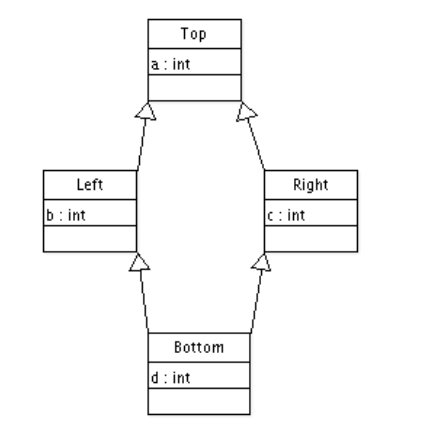
while this may seem more obvious and simpler from a programmer's point of view, from the compiler's point of
view, this is vastly more complicated. Consider the layout of Bottom again. One (non) possibility is
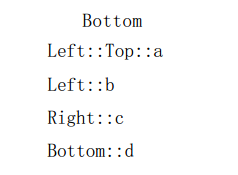
The advantage of this layout is that the first part of the layout collides with the layout of Left, and we
can thus access a Bottom easily through a Left pointer. However, what are we going to do with
Right* right = bottom;
Which address do we assign to right? After this assignment, we should be able to use right as if it were
pointing to a regular Right object. However, this is impossible! The memory layout of Right itself is
completely different, and we can thus no longer access a “real” Right object in the same way as an upcasted
Bottom object. Moreover, no other (simple) layout for Bottom will work.
The solution is non-trivial. We will show the solution first and then explain it.

You should note two things in this diagram. First, the order of the fields is completely different (in fact,
it is approximately the reverse). Second, there are these new vptr pointers. These attributes are
automatically inserted by the compiler when necessary (when using virtual inheritance, or when using virtual
functions). The compiler also inserts code into the constructor to initialise these pointers.
The vptrs (virtual pointers) index a “virtual table”. There is a vptr for every virtual base of the class.
To see how the virtual table (vtable) is used, consider the following C++ code
Bottom* bottom = new Bottom(); Left* left = bottom; int p = left->a;
The second assignment makes left point to the same address as bottom (i.e., it points to the “top” of the
Bottom object). We consider the compilation of the last assignment (slightly simplified):
movl left, %eax # %eax = left movl (%eax), %eax # %eax = left.vptr.Left movl (%eax), %eax # %eax = virtual base offset addl left, %eax # %eax = left + virtual base offset movl (%eax), %eax # %eax = left.a movl %eax, p # p = left.a
In words, we use left to index the virtual table and obtain the “virtual base offset” (vbase). This offset
is then added to left, which is then used to index the Top section of the Bottom object. From the diagram,
you can see that the virtual base offset for Left is 20; if you assume that all the fields in Bottom are 4
bytes, you will see that adding 20 bytes to left will indeed point to the a field.
With this setup, we can access the Right part the same way. After
Bottom* bottom = new Bottom(); Right* right = bottom; int p = right->a;
right will point to the appropriate part of the Bottom object:

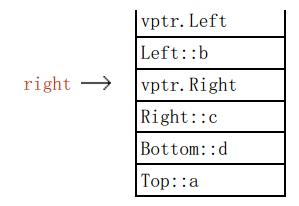
The assignment to p can now be compiled in the exact same way as we did previously for Left. The only
difference is that the vptr we access now points to a different part of the virtual table: the virtual base
offset we obtain is 12, which is correct (verify!). We can summarise this visually:

Of course, the point of the exercise was to be able to access real Right objects the same way as upcasted
Bottom objects. So, we have to introduce vptrs in the layout of Right (and Left) too:

Now we can access a Bottom object through a Right pointer without further difficulty. However, this has come
at rather large expense: we needed to introduce virtual tables, classes needed to be extended with one or
more virtual pointers, and a simple attribute lookup in an object now needs two indirections through the
virtual table (although compiler optimizations can reduce that cost somewhat).
Downcasting
As we have seen, casting a pointer of type DerivedClass to a pointer of type SuperClass (in other words,
upcasting) may involve adding an offset to the pointer. One might be tempted to think that downcasting (going
the other way) can then simply be implemented by subtracting the same offset. And indeed, this is the case
for non-virtual inheritance. However, virtual inheritance (unsurprisingly!) introduces another complication.
Suppose we extend our inheritance hierarchy with the following class.
class AnotherBottom : public Left, public Right {p ublic: int e; int f; };
The hierarchy now looks like
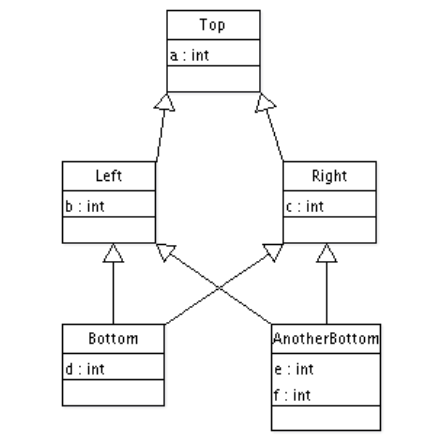
Now consider the following code.
Bottom* bottom1 = new Bottom(); AnotherBottom* bottom2 = new AnotherBottom(); Top* top1 = bottom1; Top* top2 = bottom2; Left* left = static_cast<Left*>(top1);
The following diagram shows the layout of Bottom and AnotherBottom, and shows where top is pointing after the
last assignment.
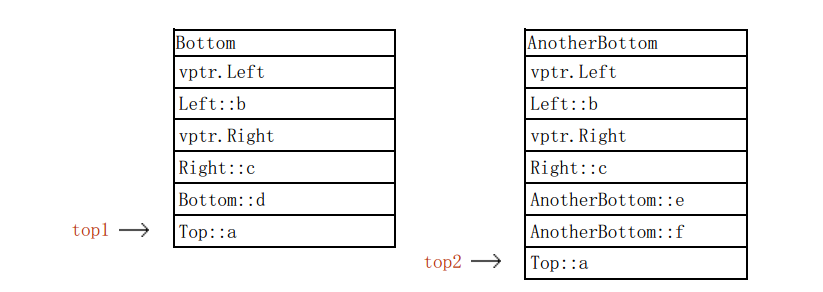
Now consider how to implement the static cast from top1 to left, while taking into account that we do not
know whether top1 is pointing to an object of type Bottom or an object of type AnotherBottom. It can't be
done! The necessary offset depends on the runtime type of top1 (20 for Bottom and 24 for AnotherBottom). The
compiler will complain:
error: cannot convert from base `Top' to derived type `Left' via virtual base `Top'
Since we need runtime information, we need to use a dynamic cast instead:
Left* left = dynamic_cast<Left*>(top1);
However, the compiler is still unhappy:
error: cannot dynamic_cast `top' (of type `class Top*') to type `class Left*' (source type is not polymorphic)
The problem is that a dynamic cast (as well as use of typeid) needs runtime type information about the object
pointed to by top1. However, if you look at the diagram, you will see that all we have at the location
pointed to by top1 is an integer (a). The compiler did not include a vptr.Top because it did not think that
was necessary. To force the compiler to include this vptr, we can add a virtual destructor to Top:
class Top { public: virtual ~Top() {} int a; };
This change necessitates a vptr for Top. The new layout for Bottom is
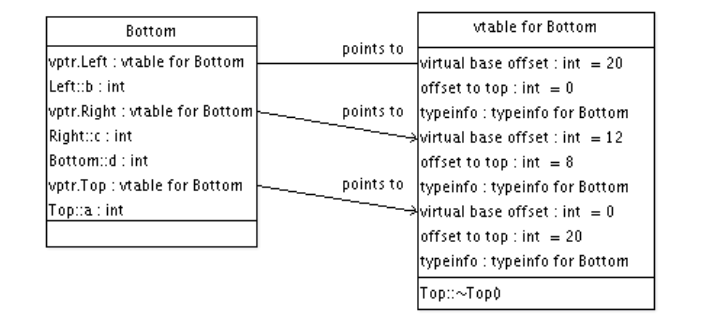
(Of course, the other classes get a similar new vptr.Top attribute). The compiler now inserts a library call
for the dynamic cast:
left = __dynamic_cast(top1, typeinfo_for_Top, typeinfo_for_Left, -1);
This function __dynamic_cast is defined in libstdc++ (the corresponding header file is cxxabi.h); armed with
the type information for Top, Left and Bottom (through vptr.Top), the cast can be executed. (The -1 parameter
indicates that the relationship between Left and Top is presently unknown). For details, refer to the
implementation in tinfo.cc.
Concluding Remarks
Finally, we tie a couple of loose ends.
(In)variance of Double Pointers
This is were it gets slightly confusing, although it is rather obvious when you give it some thought. We
consider an example. Assume the class hierarchy presented in the last section (Downcasting). We have seen
previously what the effect is of
Bottom* b = new Bottom(); Right* r = b;
(the value of b gets adjusted by 8 bytes before it is assigned to r, so that it points to the Right section
of the Bottom object). Thus, we can legally assign a Bottom* to a Right*. What about Bottom** and Right**?
Bottom** bb = &b;
Right** rr = bb;
Should the compiler accept this? A quick test will show that the compiler will complain:
error: invalid conversion from `Bottom**' to `Right**'
Why? Suppose the compiler would accept the assignment of bb to rr. We can visualise the result as:
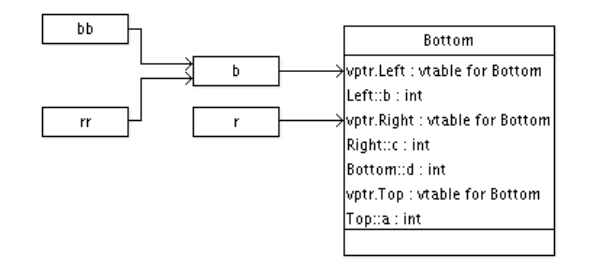
So, bb and rr both point to b, and b and r point to the appropriate sections of the Bottom object. Now consider what happens when we assign to *rr (note that the type of *rr is Right*, so this assignment is
valid):
*rr = b;
This is essentially the same assignment as the assignment to r above. Thus, the compiler will implement it
the same way! In particular, it will adjust the value of b by 8 bytes before it assigns it to *rr. But *rr
pointed to b! If we visualise the result again:
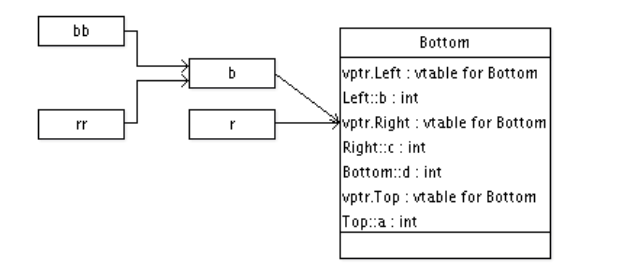
This is correct as long as we access the Bottom object through *rr, but as soon as we access it through b
itself, all memory references will be off by 8 bytes — obviously a very undesirable situation.
So, in summary, even if *a and *b are related by some subtyping relation, **a and **b are not.
Constructors of Virtual Bases
The compiler must guarantee that all virtual pointers of an object are properly initialised. In particular,
it guarantees that the constructor for all virtual bases of a class get invoked, and get invoked only once.
If you don't explicitly call the constructors of your virtual superclasses (independent of how far up the
tree they are), the compiler will automatically insert a call to their default constructors.
This can lead to some unexpected results. Consider the same class hierarchy again we have been considering so
far, extended with constructors:
class Top {p ublic: Top() { a = -1; } Top(int _a) { a = _a; } int a; }; class Left : public Top {p ublic: Left() { b = -2; } Left(int _a, int _b) : Top(_a) { b = _b; } int b; }; class Right : public Top {p ublic: Right() { c = -3; } Right(int _a, int _c) : Top(_a) { c = _c; } int c; }; class Bottom : public Left, public Right {p ublic: Bottom() { d = -4; } Bottom(int _a, int _b, int _c, int _d) : Left(_a, _b), Right(_a, _c) { d = _d; } int d; };
(We consider the non-virtual case first.) What would you expect this to output:
Bottom bottom(1,2,3,4); printf("%d %d %d %d %d ", bottom.Left::a, bottom.Right::a, bottom.b, bottom.c, bottom.d);
You would probably expect (and get)
1 1 2 3 4
However, now consider the virtual case (where we inherit virtually from Top). If we make that single change,
and run the program again, we instead get
-1 -1 2 3 4
Why? If you trace the execution of the constructors, you will find
Top::Top() Left::Left(1,2) Right::Right(1,3) Bottom::Bottom(1,2,3,4)
As explained above, the compiler has inserted a call to the default constructor in Bottom, before the
execution of the other constructors. Then when Left tries to call its superconstructor (Top), we find that
Top has already been initialised and the constructor does not get invoked.
To avoid this situation, you should explicitly call the constructor of your virtual base(s):
Bottom(int _a, int _b, int _c, int _d): Top(_a), Left(_a,_b), Right(_a,_c) { d = _d; }
Pointer Equivalence
Once again assuming the same (virtual) class hierarchy, would you expect this to print “Equal”?
Bottom* b = new Bottom(); Right* r = b; if(r == b) printf("Equal! ");
Bear in mind that the two addresses are not actually equal (r is off by 8 bytes). However, that should be
completely transparent to the user; so, the compiler actually subtracts the 8 bytes from r before comparing
it to b; thus, the two addresses are considered equal.
Casting to void*
Finally, we consider what happens we can cast an object to void*. The compiler must guarantee that a pointer
cast to void* points to the “top” of the object. Using the vtable, this is actually very easy to implement.
You may have been wondering what the offset to top field is. It is the offset from the vptr to the top of the
object. So, a cast to void* can be implemented using a single lookup in the vtable. Make sure to use a
dynamic cast, however, thus:
dynamic_cast<void*>(b);